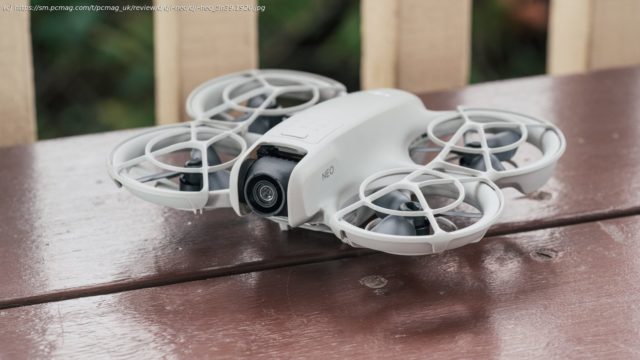A light, tiny drone for selfies and social
The DJI Neo ($199) is the smallest, lightest drone in the company’s wide range of quadcopters—and the most affordable. While many of DJI’s drones are aimed at creators and indie filmmakers, the Neo is made so that anyone can go out and get an aerial selfie or landscape shot to share on their social channels. In that way, it’s the point-and-shoot camera of drones. Professional pilots should steer clear as its hardware falls short of FAA requirements for commercial use, but creators who’ve never used a drone before and want something that’s easy, affordable, and safe to fly should look at the Neo. That said, if you’re willing to spend more, both DJI’s Mini 3 ($419) and Mini 4 Pro ($759) are more versatile drones that deliver better video quality.Design: DJI’s Smallest, Lightest Drone Yet
The Neo’s size is one of its defining characteristics and features. The drone is small enough to take off from and land in the palm of your hand, and since its airframe includes guards around the propellers, chances of injury are greatly reduced. Despite its wee dimensions, the Neo includes a 4K30 camera with single-axis gimbal stabilization, a decent 18 minutes of flight time per battery charge, and 22GB of internal storage.
By the numbers, the Neo measures 1.9 by 5.1 by 6.2 inches (HWD) and weighs 4.8 ounces (135g). The FAA requires registration for drones that weigh 249g or more, so the Neo falls outside those requirements. That means anyone can pick it up and fly it for fun, the only requirement is passing the free Trust test, which you can take online and finish in around a half hour. The Trust exam is presented like corporate training and gives a decent overview, but if you’ve never tried a drone before, be sure to read our story on drone regulations in the US.
On the other hand, professional pilots with a Part 107 sUAS certificate should skip the Neo. The FAA has stricter rules for pilots who make money with a drone, a category that includes creators with monetized YouTube channels, product reviewers, realtors, and others who receive monetary compensation for drone flights.
Pros are required to use drones with Remote ID for outdoor flights. That means pros will either need to add an external radio transmitter to the drone itself or only fly at an FAA-Recognized Identification Area (FRIA), which you can find via this map. Adding a module to such a light aircraft is problematic, however, as there’s not much room on the airframe to attach one, and even a light add-on like the 14g Holy Stone Remote ID is enough to impact battery life—DJI tells us that adding 14g to the drone will cut its flight time by two to three minutes, and you’ll need to take care to mount it near the drone’s center of gravity to ensure stable flight. Likewise, restricting operations to an FRIA really limits where you can fly. The Neo is simply not a good buy for pro pilots.
Beginners, on the other hand, are sure to like its ease of use. The Neo pairs with your smartphone and works with the DJI Fly app (free for iOS and Android). The app shows a view from the camera and includes touch controls for manual flight plus automated camera moves.
One note: DJI Fly is not in the Google App Store, so Android owners need to download it straight from DJI, whereas iPhone owners can get it straight from the Apple App Store. If you prefer the feel of a real remote control in your hands, you can add the RC-N3 remote for $129. The RC-N3 includes two analog control sticks and provides a stronger communication link to the drone than your phone, which is limited to about 165 feet of range. With the remote, there’s no restriction; you can easily fly the drone as far as legally allowed without interruptions to the camera feed.
You’ll need to buy the drone and remote separately, as DJI does not offer them in a bundle. However, it does have an extra battery bundle, the Neo Fly More Combo ($289), which includes the drone, three flight batteries, and a three-way charging hub. Spare batteries are $39 a la carte, and the charger is $35, so the bundle represents a modest $24 discount versus individual pricing. The Competition: Few Drones Are This Small
The DJI Neo is smallest and lightest drone from DJI, but not the only one that falls in the under-249g weight class. The DJI Mini 2 SE ($279) and Mini 2 4K ($299) are upgrade options that have more robust 3-axis gimbal stabilization and ship with remote controls, but also omit Remote ID.
The Mini 3 includes Remote ID, so it’s suitable for pros and casual pilots alike. It also has longer flight times than the Mini 2, ships with a remote control, and an upgraded camera that swaps between landscape and vertical aspect ratios. The Mini 4 Pro is another step up; it’s essentially a Mini 3 with the addition of obstacle avoidance sensors, which are missing from the Neo, the Mini 2, and the Mini 3.
All of DJI’s other ready-to-fly drones weigh more than 249g, so they must be registered with the FAA prior to flight, even if only used recreationally.






